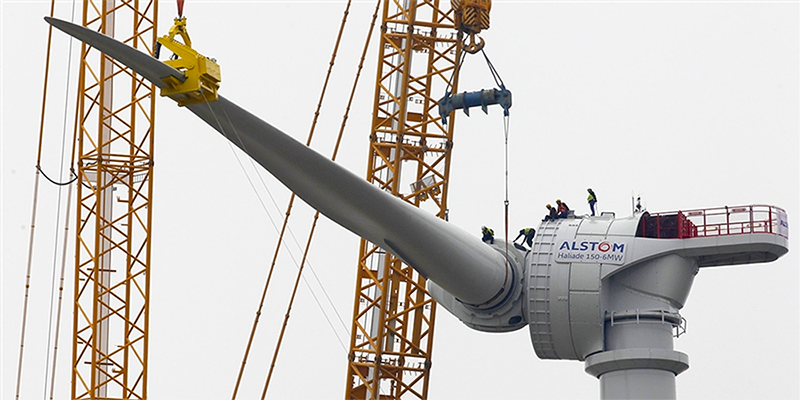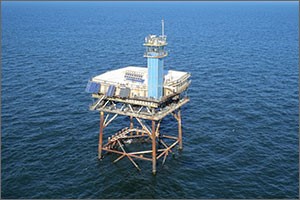Research
Background
The National Perspective

The United States has just under 20% of the world’s total wind capacity and produces just over 25% of the world’s total wind-generated electricity. U.S. wind farms are all land-based, with five states accounting for nearly half of the national total installed capacity: Texas (12.2 GW), California (5.5 GW), Iowa (5.1 GW), Illinois (3.6 GW), and Oregon (3.2 GW).
The Alta Wind Energy Center at Tehachapi Pass in Kern County, California is the second largest wind farm in the world, with a combined installed capacity of 1,320 MW next only to the 1,064 MW Jaisalmer Wind Park in Rajasthan, India. The next largest U.S. project is the Roscoe Wind Farm, with a total capacity of 782 MW. At present, the Mid-Atlantic region is the closest to realizing commercial development of offshore wind power in the United States. A total of seven offshore wind energy areas (WEAs) have been designated by the U.S. Bureau of Ocean Energy Management (BOEM) in federal waters on the outer continental shelf between Cape Cod and Cape Hatteras: the Rhode Island – Massachusetts Area of Mutual Interest, and WEAs off New York, New Jersey, Delaware, Maryland, Virginia, and North Carolina. Researchers at VT-ARI have estimated that the four WEAs off New Jersey, Delaware, Maryland, and Virginia alone have a potential offshore wind capacity of approximately 17 GW, more than three times the global offshore wind capacity installed to date.

Wind Power in Virginia
Virginia is the second largest importer of electricity among U.S. states. In 2011, our total electricity demand was 111.6 million MWh, of which 40% was imported, and Virginia’s electricity imports have doubled in the last 11 years. Virginia’s WEAs can generate 10.1 million MWh per year, potentially cutting state electricity imports by 23%.
Although the contribution of offshore wind power to Virginia’s electricity supply portfolio can be significant, its economic development and job creation opportunity is particularly compelling. VT-ARI has estimated that if Hampton Roads shipyards can win the foundation substructure fabrication contracts for the four nearby offshore WEAs they would create just over 5,000 direct jobs over a 10-year build-out period.

Tower fabrication and assembly of offshore wind turbine rotor-nacelle assemblies are even more impressive job creators. In April 2012, the French company Alstom announced that its consortium partnership with Electricité de France had won 1,500 MW worth of offshore leases from the French government. This represents an order pipeline of about 240 6-MW turbines, worth more than 2 billion euros ($2.6 billion). Alstom will invest about 100 million euros [$130 million] and create 5,000 direct and indirect jobs in French manufacturing and assembly facilities that will make towers, blades, generators and nacelles for its 6-MW Haliade turbines, the first prototype of which was installed in March 2012.
A further DOE-funded activity off Virginia centers on the Chesapeake Light Tower, where DOE will establish a Reference Facility for Offshore Renewable Energy (RFORE) to be fully operational by August 2015. RFORE is intended to be a public-private partnership that will allow partnership activities to address key metocean research programs and specific offshore renewable energy questions, as well as provide an opportunity for other scientific uses of the platform by the stakeholder community to advance their own efforts.
To accelerate realization of the energy and economic benefits of offshore wind, the Virginia Department of Mines, Minerals and Energy A further DOE-funded activity off Virginia centers on the Chesapeake Light Tower, where DOE will establish a Reference Facility for Offshore Renewable Energy (RFORE) to be fully operational by August 2015. RFORE is intended to be a public-private partnership that will allow partnership activities to address key metocean research programs and specific offshore renewable energy questions, as well as provide an opportunity for other scientific uses of the platform by the stakeholder community to advance their own efforts. (DMME) has applied for two research leases in and adjacent to the Virginia offshore WEAs. The first, which was just awarded, is intended to provide long-term measurement and environmental monitoring from two dedicated platforms. The second lease is located just west of and adjacent to the Virginia areas, and is intended to host two Alstom turbines that will demonstrate advanced technologies to lower the cost of offshore wind energy. This Virginia Offshore Wind Technology Advancement Project (VOWTAP) is one of seven such demonstration projects that have each received $4 million in Phase I funding from the U.S. Department of Energy (DOE) with potential for an additional $47 million for construction allowing operations to begin in 2017. This effort is being led by Dominion Virginia Power, and includes Alstom, Kellogg Brown & Root, the National Renewable Energy Laboratory, DMME, VT-ARI, Newport News Shipbuilding, and Tetra Tech as partners.


